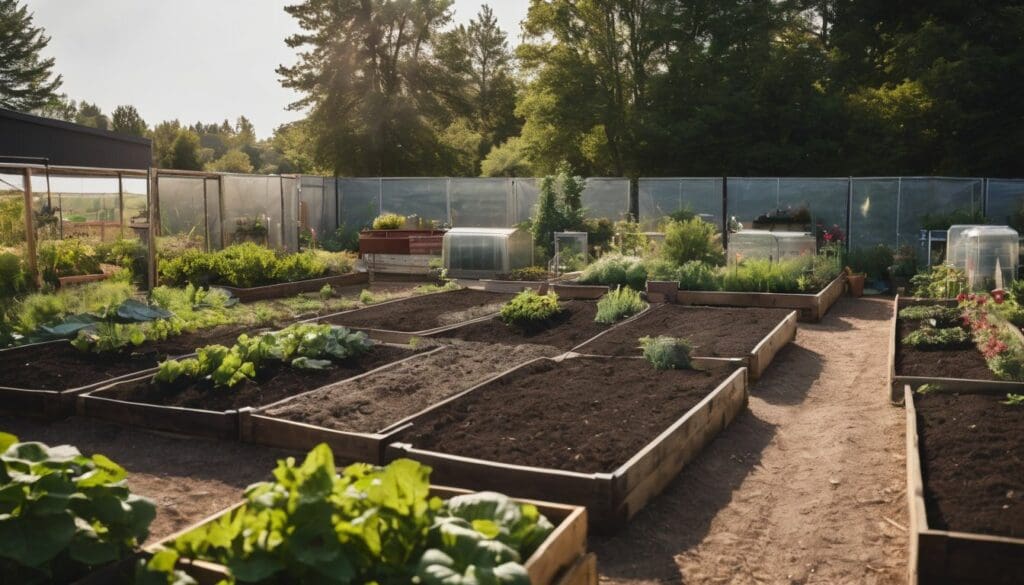Do you ever find yourself wincing as you bin the remnants of your kitchen endeavours, nagged by a sense of wastefulness? You’re certainly not on your own. Recent figures suggest that an average household might generate upwards of 70 kilos of organic waste each year.
Our team has been exploring sustainable practices and we’re quite keen to walk you through establishing a thriving local compost exchange. Just imagine transforming those forgotten fridge leftovers into nourishing soil for community gardens – it’s simpler than you think! What’s more, it’s a step towards sustainability that can be shared with neighbours and friends alike.
Join us as we unveil how easy it can be to make a real difference in our local environment – are you ready to get started?.
Key Takeaways
- Create a local compost exchange by engaging neighbours, securing an accessible site approved by local authorities, and ensuring there’s access to water for maintaining compost piles.
- Educate the community on the benefits of food scrap recycling such as reducing landfill waste, creating nutrient-rich soil for gardens, and lowering greenhouse gas emissions.
- Appoint a dedicated team captain to organise activities including a centralised drop-off point, a regular pick-up day schedule, and community workshops or events.
- Maintain active participation in the compost exchange program with regular membership renewals and consider joining larger citywide composting services to enhance environmental impact.
- Promote the neighborhood compost exchange through flyers and social media while providing education on effective waste management practices.
What is Food Scrap Recycling?
Transitioning from the broader view of waste management, let’s delve into food scrap recycling. This process involves collecting leftover bits from meals and kitchen prep – think fruit peels, vegetable trimmings, coffee grounds, and eggshells.
Instead of tossing these scraps into the garbage where they’ll head straight to landfills, we recycle them. By doing so, we turn organic materials back into valuable resources for our gardens and landscape.
We all have a part in reducing waste with every peel and core thrown into a compost bin rather than a trash can. Food scrap recycling isn’t just about getting rid of leftovers; it’s a cycle that brings nutrients back to the soil while cutting down on harmful greenhouse gases produced by decomposing food in landfills.
It’s an easy step towards more sustainable living as we collectively transform what used to be waste into compost that enhances plant growth and fosters green spaces around us.
Benefits of Composting Your Food Scraps
Composting food scraps reduces waste sent to landfills, provides nutrient-rich soil for gardening, and helps reduce greenhouse gas emissions. This sustainable practice supports a healthier environment and contributes to green living initiatives in our community.
Reduces waste sent to landfills
By composting our food scraps, we significantly reduce the amount of waste sent to landfills. When organic matter breaks down in landfills, it produces methane – a potent greenhouse gas that contributes to climate change.
By diverting food scraps from landfills and turning them into nutrient-rich soil through composting, we can help lessen the environmental impact of waste disposal while enriching our gardens and green spaces with natural fertiliser.
When we choose to compost, we actively participate in reducing the burden on landfill sites and lower greenhouse gas emissions. Composting at a community level not only benefits individual households but also has a positive impact on the environment as a whole.
Provides nutrient-rich soil for gardening
Composting food scraps provides nutrient-rich soil for gardening. This fertile compost enriches the soil with essential nutrients, improving plant growth and health.
The process of composting also creates a rich humus that improves the structure of the soil, helping it to retain moisture and suppress plant diseases. This benefits local gardens and promotes sustainable gardening practices within the community.
Helps reduce greenhouse gas emissions
Operating a neighbourhood compost exchange helps reduce greenhouse gas emissions by diverting organic waste from landfills, where it would release methane—a potent greenhouse gas upon decomposition.
By composting food scraps locally, we minimise the need for long-distance transportation of organic waste to distant landfills, thus reducing associated emissions. Through our collective efforts in community composting, we contribute to mitigating climate change and fostering a more sustainable environment.
In addition to cutting down on landfill emissions, setting up a local compost exchange aids in sequestering carbon from the atmosphere. The process of converting organic waste into nutrient-rich soil through composting effectively traps carbon within the soil, further aiding in lowering greenhouse gas levels.
How to Start and Run a Community Compost Site
We’ll show you how to get your neighbours involved and set up a compost site in your community. Read on to learn more about the benefits of food scrap recycling, setting up a compost exchange, and joining citywide composting services.
Get to know your neighbours and secure a site
To get the community involved, start by engaging with your neighbours to gauge their interest in setting up a compost exchange. A central part of this process entails securing an appropriate site for the compost hub.
It’s crucial to identify a location accessible to all participants and compliant with any local regulations regarding waste management. This means considering factors such as proximity, space availability, and potential environmental impact.
Once you’ve established a suitable site, it’s time to engage with local authorities or property owners to gain permission for using the designated area as a community compost hub. Working collaboratively with your neighbours and obtaining necessary approvals ensures that the project is both sustainable and well-received within the community.
Map out the composting process
To begin, familiarise yourself with the neighborhood’s composting needs. Next, identify suitable organic materials for composting such as fruit and vegetable scraps, coffee grounds, eggshells, and yard trimmings. Then, designate separate containers for green (nitrogen-rich) and brown (carbon-rich) materials to maintain the ideal balance. Position the site in an area with proper drainage and easy access for turning the pile. Additionally, monitor the temperature and moisture levels regularly to ensure effective decomposition. Finally, arrange a schedule for turning the compost and note when it’s ready for use on local gardens.
Make arrangements for a water source
To ensure the success of our community composting site, we need to secure a reliable water source for the composting process. This is crucial as water is essential for maintaining the right moisture levels in the compost piles, aiding in the decomposition process.
By setting up access to a nearby water supply, we can make it convenient for volunteers to keep the compost moist and help accelerate the breakdown of organic materials.
Once we have secured a nearby water source, we can proceed with confidence knowing that our community composting efforts are set up for success. With this important step completed, we will be one step closer to reaping the benefits of nutrient-rich soil and reduced waste sent to landfills through food scrap recycling.
Promote and maintain the site
To ensure the success of our neighbourhood compost exchange, we can promote and maintain the site by implementing the following strategies:
- Spread awareness through flyers, social media, and word of mouth to encourage participation in the compost exchange.
- Organise regular workshops or information sessions to educate community members about the benefits of composting and how to effectively participate in the exchange.
- Collaborate with local schools or community groups to engage more people and expand the reach of our composting efforts.
- Establish a system for regular site maintenance, such as cleaning bins, monitoring compost quality, and ensuring proper functioning of the drop-off spot.
- Engage volunteers from the community to help with site promotion, education, and maintenance activities.
Setting Up a Neighbourhood Compost Exchange
To set up a neighbourhood compost exchange, it’s important to select a team captain and name, as well as establish a centralised drop-off spot and regular pick-up day. Renewing memberships and considering joining citywide composting services can also help maintain the exchange.
Pick a team captain and name
Select a responsible individual to lead the compost exchange and take charge of coordinating the activities. Choose someone who is passionate about sustainability and has good organisational skills.
This person will be in charge of overseeing the drop-off spot, handling pick-up days, and renewing memberships when necessary.
Consider appointing someone who lives centrally within the neighbourhood to ensure convenient access for all members. Once you have chosen your team captain, give them full support as they play an integral role in making the neighborhood compost exchange a success.
Select a centralised drop-off spot
After naming our team captain and finalising the details, we can now focus on selecting a centralised drop-off spot for our neighbourhood compost exchange. The chosen location should be easily accessible to all participants, preferably within walking distance from most homes.
When choosing the spot, consider areas with enough space to accommodate the compost containers and traffic flow for drop-offs. It’s important that the site is well-lit and secure, allowing members to access it at their convenience while keeping out unwanted materials.
We must also ensure that the chosen spot complies with local regulations concerning waste disposal. By taking these considerations into account, we can create a convenient and sustainable system for food scrap collection in our community.
Establish a regular pick-up day
After selecting a centralised drop-off spot, it’s essential to establish a regular pick-up day for the neighborhood compost exchange. We need to decide on a specific day of the week when members can bring their food scraps and collect finished compost.
This consistent schedule helps everyone plan and ensures that there is always fresh compost available. Regular pick-up days promote community involvement and make the process convenient for all members.
We’ll also need to communicate this schedule clearly and ensure that everyone knows when they should drop off their food scraps or collect compost. By maintaining an organised and predictable routine, we can streamline the exchange process and create a successful community composting initiative that benefits both our gardens and the environment.
Renew memberships and maintain the exchange
To keep our neighbourhood compost exchange thriving, we need to focus on renewing memberships and ensuring the smooth operation of the exchange. Here are some key actions:
- Organise a membership renewal drive at least one month before expiry to ensure a continuous flow of participants.
- Communicate regularly with members through newsletters or email updates to keep them informed about exchange activities and any new initiatives.
- Arrange periodic workshops or educational events to engage existing members and attract new ones, thereby maintaining a sense of community involvement.
- Implement a feedback mechanism to gather suggestions and address any concerns, fostering a supportive environment for all participants.
Consider joining citywide composting services.
To expand the impact of our sustainability initiatives, we can explore joining citywide composting services. By participating in such programs, we can contribute to community-scale composting efforts and support local exchange of nutrient-rich soil.
This aligns with our commitment to environmental conservation and offers a convenient avenue for eco-conscious individuals to reduce waste sent to landfills while nurturing greener surroundings.
In addition, citywide composting services facilitate access to larger networks of like-minded individuals who are dedicated to promoting sustainable living practices. Becoming part of these initiatives also allows us to tap into broader resources, expertise, and support systems that can further enhance our individual and collective efforts towards achieving a more environmentally friendly neighbourhood.
Conclusion
Get ready to create an amazing neighbourhood compost exchange programme! Choose a dedicated team captain and designate a convenient drop-off spot. Set a regular pick-up day that suits everyone’s schedule.
Keep memberships active, maintain the exchange, and perhaps consider joining citywide composting services for even greater impact!
FAQs
1. What is a neighbourhood compost exchange programme?
A neighbourhood compost exchange programme is where people in the same area share and swap their organic waste at a community scale, turning it into valuable compost for everyone’s benefit.
2. How do you start a community-scale composting scheme?
To start, gather neighbours interested in recycling their food scraps and garden trimmings; choose someone to be the team captain; set up a regular compost dropoff and pickup system to manage the collection of materials.
3. What day should we have as our neighbourhood compost pickup day?
You could decide on a specific day of the week that works best for most residents, such as Saturday or Sunday, when people are more likely to be home to contribute their organic waste.
4. Why select a team captain for our local compost exchange?
A team captain can organise and lead efforts in setting up your neighbourhood’s community-scale composter by coordinating with residents, scheduling dropoff times, and ensuring the process runs smoothly.





